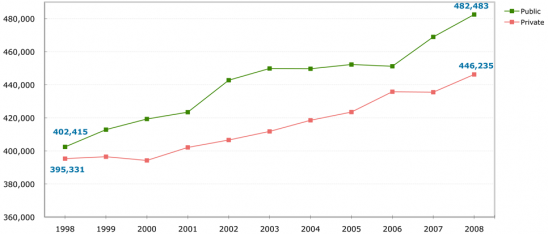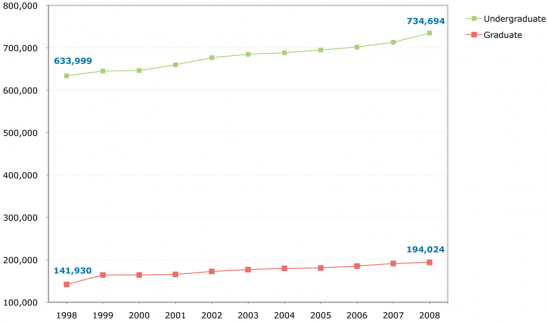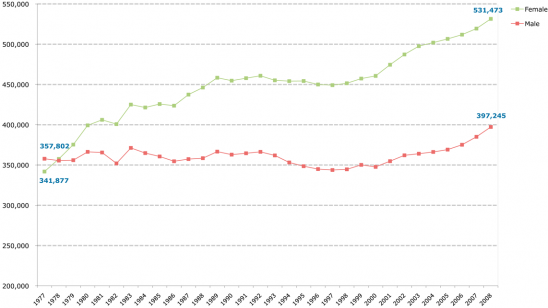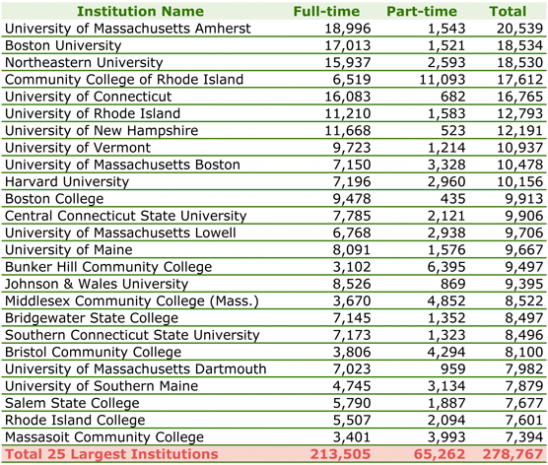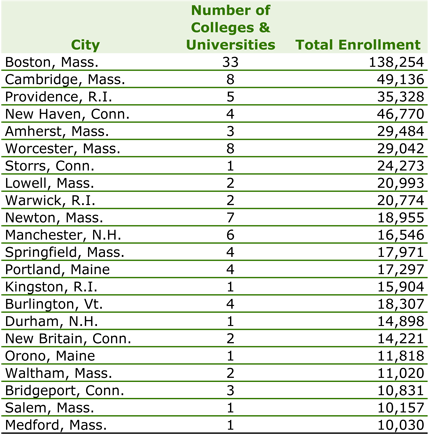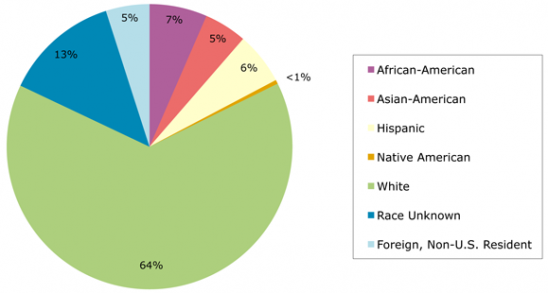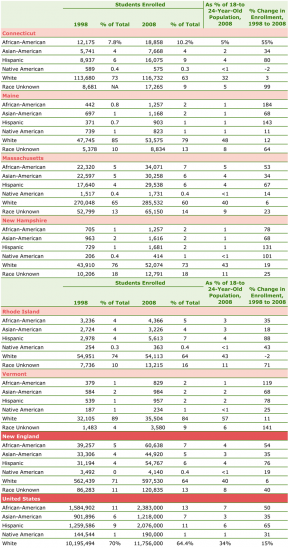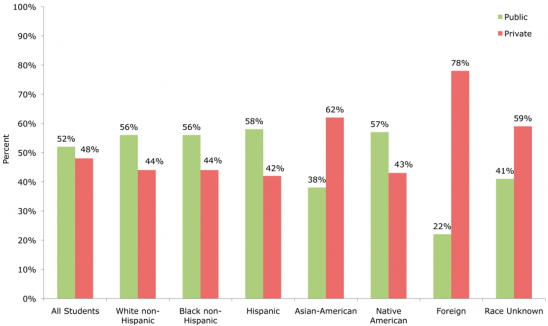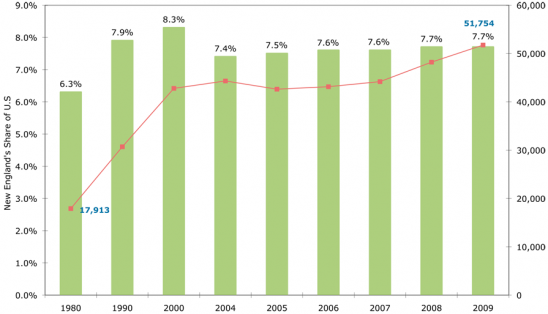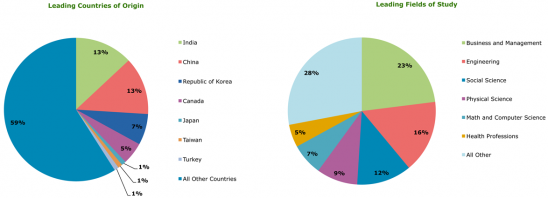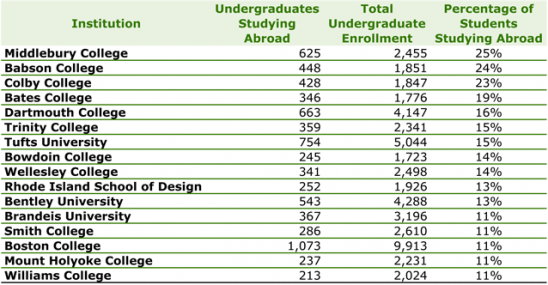- More than 928,000 students were enrolled at New England’s colleges and universities in 2008, up by more than 100,000 students over the decade.
- Nearly half of New England college students attend private institutions, compared with just over one-quarter nationally.
- Women students began to outnumber men on New England college and university campuses in 1978, and the imbalance has grown to about 531,000 women to 397,000 men.
- African-American and Hispanic college enrollments have grown in all New England states, but the groups together still account for only 13% of New England college students. Moreover, since 1990, the U.S. Education Department has provided a mechanism for U.S. citizens and resident aliens who do not wish to designate a racial/ethnic category. The category called “Race/Ethnicity unknown” has mushroomed. Also in a multiracial society, U.S. students increasingly choose to identify themselves with two or more races, though America’s multiracial president chose only one box on the U.S. Census form: “Black, African Am., or Negro.”
- Nearly 52,000 foreign students are enrolled on New England campuses, up from about 18,000 in 1980. More than one-quarter of the foreign students in New England are from India or China; nearly half are studying business or engineering.
Fig. 20: Public vs. Private College Enrollment in New England, 1998 to 2008
Click on the chart to view it full size in a new window.
Source: New England Board of Higher Education analysis of U.S. Department of Education data.
Fig. 21: Undergraduate vs. Graduate Enrollment in New England, 1998 to 2008
Click on the chart to view it full size in a new window.
Source: New England Board of Higher Education analysis of U.S. Department of Education data.
Fig. 22: Full-Time vs. Part-Time College Enrollment in New England, 1998 to 2008
Click on the chart to view it full size in a new window.
Source: New England Board of Higher Education analysis of U.S. Department of Education data.
Fig. 23: Total Higher Education Enrollment by Gender in New England, 1977 to 2008
Click on the chart to view it full size in a new window.
Source: NSF WebCASPAR Database System.
Fig. 24: New England Institutions with the Largest Undergraduate Enrollments, Fall 2008
Click on the chart to view it full size in a new window.
Source: New England Board of Higher Education analysis of U.S. Department of Education data.
Fig. 25: New England Cities with the Largest College Enrollments, 2008
Click on the chart to view it full size in a new window.
Note: Total enrollment includes full-and part-time undergraduate, graduate and non-degree students.
Source: New England Board of Higher Education analysis of U.S. Department of Education data.
Fig. 26: Enrollment at New England Colleges and Universities by Race/Ethnicity, 2008
Click on the chart to view it full size in a new window.
Note: The U.S. Department of Education’s designations of race and ethnicity differ from those of the U.S. Bureau of the Census used in other figures.
Source: New England Board of Higher Education analysis of U.S. Department of Education data.
Fig. 27: Minority Enrollment by State and Race/Ethnicity, 1998 and 2008
Click on the chart to view it full size in a new window.
Note: Table does not include enrollment at military academies. African-American, Asian-American, Native American and White totals reflect non-Hispanic population. Does not include the category non-resident alien. United States data are for 2007, the most recent data available.
Source: New England Board of Higher Education analysis of U.S. Department of Education data.
Fig. 28: Public and Private College Enrollment in New England by Race/Ethnicity and Type of Institution, 2008
Click on the chart to view it full size in a new window.
Fig. 29: Foreign Enrollment at New England Colleges and Universities and Share of U.S. Foreign Enrollment, 1980 to 2009
Click on the chart to view it full size in a new window.
Fig. 30: Foreign Students in New England by Countries of Origin and Fields of Study, 2009
Click on the chart to view it full size in a new window.
Source: New England Board of Higher Education analysis of Institute of International Education data.
Fig. 31: Estimated Economic Impact from International Students, 2007-08
Click on the chart to view it full size in a new window.
Note: U.S. funding includes support from a U.S. college or university, the U.S. government, a U.S. private sponsor or current employment.
Source: New England Board of Higher Education analysis of NAFSA: Association of International Educators data.
Fig. 32: New England Institutions Enrolling More than 1,000 Foreign Students, 2009
Click on the chart to view it full size in a new window.
Source: New England Board of Higher Education analysis of Institute of International Education data.
Fig. 33: New England Institutions with More than 10% of Undergraduates Studying Abroad, 2008
Click on the chart to view it full size in a new window.
Source: New England Board of Higher Education analysis of Institute of International Education data.
[ssba]

